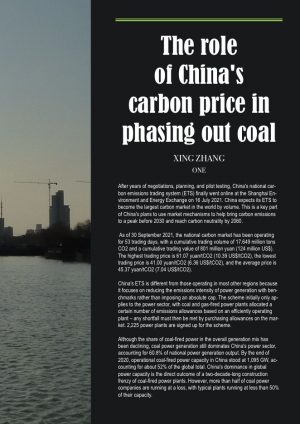 After years of negotiations, planning, and pilot testing, China’s national carbon emissions trading system (ETS) finally went online at the Shanghai Environment and Energy Exchange on 16 July 2021. China expects its ETS to become the largest carbon market in the world by volume. This is a key part of China’s plans to use market mechanisms to help bring carbon emissions to a peak before 2030 and reach carbon neutrality by 2060.
After years of negotiations, planning, and pilot testing, China’s national carbon emissions trading system (ETS) finally went online at the Shanghai Environment and Energy Exchange on 16 July 2021. China expects its ETS to become the largest carbon market in the world by volume. This is a key part of China’s plans to use market mechanisms to help bring carbon emissions to a peak before 2030 and reach carbon neutrality by 2060.
As of 30 September 2021, the national carbon market has been operating for 53 trading days, with a cumulative trading volume of 17.649 million tons CO2 and a cumulative trading value of 801 million yuan (124 million US$). The highest trading price is 61.07 yuan/tCO2 (10.39 US$/tCO2), the lowest trading price is 41.00 yuan/tCO2 (6.36 US$/tCO2), and the average price is 45.37 yuan/tCO2 (7.04 US$/tCO2).
China’s ETS is different from those operating in most other regions because it focuses on reducing the emissions intensity of power generation with benchmarks rather than imposing an absolute cap. The scheme initially only applies to the power sector, with coal and gas-fired power plants allocated a certain number of emissions allowances based on an efficiently operating plant – any shortfall must then be met by purchasing allowances on the market. 2,225 power plants are signed up for the scheme.
Although the share of coal-fired power in the overall generation mix has been declining, coal power generation still dominates China’s power sector, accounting for 60.8% of national power generation output. By the end of 2020, operational coal-fired power capacity in China stood at 1,095 GW, accounting for about 52% of the global total. China’s dominance in global power capacity is the direct outcome of a two-decade-long construction frenzy of coal-fired power plants. However, more than half of coal power companies are running at a loss, with typical plants running at less than 50% of their capacity.
Will the new carbon ETS help China to accelerate the phase out of its coal fleet?
Under China’s scheme, power plants are not penalised for operating at high capacity. Instead, the system is designed to incentivise plants to run more efficiently. This accounting method means that emissions under the ETS will not necessarily decrease.
However, the carbon price does add additional operating costs which will affect the cash flows and profitability of coal plant operation. TransitionZero’s recent analysis shows that, even without a carbon price, 36.5% of coal units are currently unprofitable. With the current average trading price of US$7/tCO2, the analysis indicates that nearly 60.9% of units may now be unprofitable.
According to Professor Xiliang Zhang from the Institute of Energy, Environment and Economics at Tsinghua University, during the “14th Five-Year Plan” period, the carbon price in China’s carbon market may reach around US$8-10/tCO2 and, during the “15th Five-Year Plan” period, the carbon price may further rise to US$15/tCO2. At this level, 85% of units today would be running at a loss.
Although the technical lifetime of a coal power plant unit is nominally 30 years, economic and policy conditions may influence China’s decision-makers to curtail the operational life of many units. Based on its own Risk Index System (RIS) ranking and China’s net-zero policy goal, TransitionZero estimated that the unit retirement age could be shortened by an average of seven years. Considering the power oversupply in China, it is almost inevitable that some coal-fired units will be shut down ahead of their designed life.
In order to meet the carbon reduction target, some provinces and cities have taken the route of coal to gas conversion. For example, Beijing has closed down all coal-fired generation units, partly replacing them with gas, and partly relying on import power. The local government of Xi’an has also recently announced plans to replace all its 30 coal-fired CHP units with gas to become a ‘no coal city’ in 2025. However, while gas generation is cleaner than coal, this approach risks locking in a new legacy of carbon emitting infrastructure.
Some experts suggest following European examples, such as the UK’s Drax power plant, by converting coal-fired power plants to fire biomass. Due to its geographical location and vast population, China is struggling to be self-sufficient for food. Major biomass resources in China include waste from agriculture, forestry, industries, animal manure and sewage, and municipal solid waste. This resource is not reliable and sustainable, and it is therefore unrealistic to expect biopower to play a substantial role in China’s energy mix.
On the other hand, solar and wind power has performed strongly in China, with significant growth in both generation and capacity. The wind capacity added to the grid in 2020 achieved a record year-on-year growth rate of 178.7%, exceeding the total added wind capacity from 2017 to 2019. In 2020, China accounted for more than half of the offshore wind capacity installed globally that year. The country’s installed solar capacity increased 92%.
However, this growth alone is not enough to meet the electricity demand. Only a third of China’s increase in electricity demand was met from gains in wind and solar generation. Another third was from increased hydro, nuclear and bioenergy, leaving a need for increased coal generation. There is a big power demand gap for wind and solar to fill.
What is a viable route to decarbonise China’s power sector to achieve its carbon neutral target? Although an absolute emission cap would be more efficient, the carbon price has certainly added some weight to the Chinese coal-fired power generation sector, and should result in more coal-fired units taking early retirement.
Solar and wind are the most suitable options to replace these early retired coal-fired units, as China dominates in the development of solar energy and battery storage. Further expansion of this clean grid infrastructure will reduce solar and wind energy production costs and make it even more competitive with coal.
Xing Zhang





